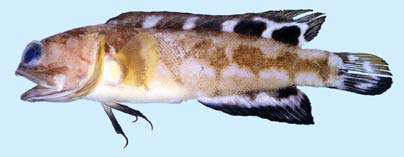OPISTOGNATHIDAE
Jawfishes
By Hiroyuki Motomura and Ukkrit Satapoomin
 Opistognathus nigromarginatus |
 Opistognathus rosenbergii |
|
Generally small-sized (most less than 12 cm total length), moderately elongate fishes. Head bulbous. Eye relatively large, oriented dorsolaterally. Mouth large, posterior margin of maxilla extending well beyond eye. Dorsal fin with IX to XII spines and 10 to 22 soft rays; shallowly notched between spinous and soft-rayed portions. Anal fin with II or III spines and 10 to 20 soft rays. Caudal and pectoral fins rounded. Pelvic fins with I spine and 5 soft rays; outer 2 soft rays unbranched and stout, inner rays branched and weaker. Lateral line incomplete, usually ending below about middle of dorsal fin; lateral line tubes or canals usually embedded in skin; scales cycloid. Color: mottled with various shades of brown in most species. Similar families occurring in the area. Pelvic fin characters (see above description) distinguish Opistognathidae from all other families. Remarks. Occurs in shallow waters to depths of 30 m on sandy substrates in most species, from depths exceeding 200 m in some species. Inhabiting in burrows and usually found with only their heads protruding from the burrow. Living in small colonies in most species, but solitude in some species. All species are mouth brooders. |

|
|